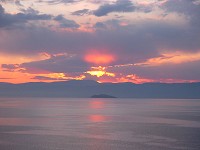| Origin & Development | |
|
Legends & Fairy tales • Earth's Crust Thickness • Underwater Relief • Landscapes • History & Formation • Seismic Activity • | |
| History of Lake Baikal | |
|
History of Explorations • Inhabitants & Settlers • First maps of Baikal • Archaeological Sites • | |
| Lake Baikal Climate | |
|
Introduction • Fogs • Winds & Waves • Ice Conditions • | |
| Fauna & Vegetation | |
|
Mammals • Baikal seal - Nerpa • Ichthyofauna • Invertebrates • Vegetation • | |
| Water of Lake Baikal | |
|
Colour • Transparency • Temperature • Pressure • Depth • Currents • Budget • Chemical Composition • Pollution • | |
| Recreational Areas | |
|
Circumbaikal Railway • Peschanaya Bays • Olkhon Island • Chivirkuysky Gulf • Wooden Irkutsk • Trans-Siberian Railway • | |
| People of Lake Baikal | |
|
People of Siberia • Buryat nation in Baikal • Russians in Baikal • | |
|
| |
Lake Baikal Seismic Activity
Seismicity: Annual number of earthquakes: >2000 Earthquakes' recurrence (Mg - magnitude): Mg - 5: 1 - 2 years Mg - 6: 5 - 10 years Mg - 7: 50 - 100 years Mg > 7: 150 - 200 years The strongest earthquakes: 1. Tsaganskoe, 1862 - formation of Proval Bay: Mg > 6.5-7 2. Srednebaikalskoe, 1959: Mg > 6 (Baikal bottom subsidence in the epicenter was up to 15-20 m) 3. Chivirkuyskoye, 1981: Mg - 5.8 4. South Baikal, 1999: Mg - 5.8 Earthquakes' epicenter depth: 12 - 22 km Maximum altitude of the mountain ridges around Baikal (the Barguzin mountain range): 2840 m Maximum depth of Baikal: 1637 m Maximum thickness of sediments in Baikal basin (geophysical data): 8500 m Amplitude of the rift slit between the maximum altitude of the mountain ridge and the basement of Baikal basin: 12977 m To compare: Maximum ocean depth (Mariana Trench in the Pacific Ocean): 11022 m |
